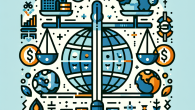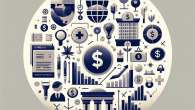
Capital Flows and Currency Volatility: A Behavioural Finance Perspective
The Return of Inflation: What Global Markets Should Brace For
As the world quietly emerged from a global health crisis, many policymakers hoped for a gentle economic recovery, a soft landing if you will. But alas, reality has proven to be far less… pastoral. Enter center stage: inflation, once presumed tamed, now roaring back with theatrical flair. And as any serious observer of global markets knows, when inflation rises from the ashes, she rarely comes alone.
Let us examine this economic phoenix not with panic, but with perspective—and a splash of proper sophistication befitting those of us who prefer their data with a dram of Scotch.
What Exactly Is Happening With Inflation?
Beginning in late 2020, global inflation started ticking upward. By 2022, it had gone from “concerning” to “egregious” in many developed economies. In the United States, the Consumer Price Index (CPI) peaked above 9%—the highest in over 40 years. The Eurozone saw double-digit headline inflation, and even the normally sedate Bank of England was compelled to scramble like a man late for afternoon tea.
Today, central banks have responded en masse with aggressive interest rate hikes aimed at “cooling the economy.” This is central bank jargon for “trying not to choke the patient while reducing the fever.” But are they succeeding? That depends on how you define success—and how you interpret data through the lens of economic theory.
Understanding the Roots of the Current Inflation Cycle
There are a host of factors from different economic corners that cultivated this inflationary environment. Let’s explore a few:
- Supply Chain Disruptions: COVID-19 lockdowns shuttered factories, clogged shipping lanes, and left retailers scrambling for inventory. A scarcity of goods with steady demand? A perfect recipe for inflation.
- Pent-Up Demand: Households, particularly in developed nations, burst forth from pandemic restrictions filled with cash from generous stimulus cheques, eager to spend. Cue a demand bonanza that would make Keynes grin in his grave.
- Generous Monetary and Fiscal Policies: Central banks expanded balance sheets at record levels. Meanwhile, fiscal authorities sprayed liquidity like confetti at a royal wedding.
- Commodity Price Shocks: Russia’s invasion of Ukraine rattled energy and food markets globally. Oil, natural gas, wheat—you name it, prices spiked, feeding directly into CPI.
Say what you will about the resilience of capitalism, but even it cannot shake off such a concatenation of shocks without consequence.
What This Means for Global Markets
Capital markets and inflation have a longstanding, complicated relationship—akin to an arranged marriage between two nobles with clashing temperaments. When inflation accelerates, so does volatility across equities, bonds, currencies, and commodities.
Equities Face a Valuation Conundrum
Higher inflation often results in higher interest rates. This, in turn, raises the discount rate applied to future earnings. The outcome? Lower valuation multiples, particularly for tech and growth stocks that rely on a future promise versus current profits. Dividend-heavy sectors like utilities and real estate investment trusts (REITs) also suffer as their yields must now compete with rising bond yields.
On the flip side, sectors like energy, industrials, and financials often outperform during inflationary cycles thanks to pricing power or rising rate environments.
Bonds Are No Longer the Safe Harbor
The bond market has experienced what can only be described as an imperial collapse. Long-duration government bonds—once deemed the epitome of safety—have seen their worst losses in decades. As yields rise, bond prices fall, leading to negative returns for the “safe” portion of traditional 60/40 portfolios.
Investors are being forced back to basics: looking for short-duration, inflation-protected, or floating-rate instruments to weather the storm.
Currency Volatility and Capital Flows
When multiple central banks raise rates simultaneously but unevenly, expect immense currency dislocations. The U.S. Dollar Index reached heights unseen in two decades in 2022 due to aggressive Federal Reserve policy. Conversely, developing economies with weaker fiscal anchors saw capital outflows and currency depreciation, further fueling inflation locally.
In short: currency speculators are having a field day, while importers in emerging markets are revisiting hedging strategies with a newfound urgency.
The Macroeconomic Implications
One must remember that inflation is not merely a market event—it is a social and political accelerant. Elevated prices for basic goods erode real incomes, disproportionately affecting lower- and middle-class households. Prolonged inflation leads to reduced consumer spending, slower economic growth, and increased public dissent.
Central banks, especially the Federal Reserve, face a subtle but deadly challenge: combat inflation without triggering a recession. It is the equivalent of performing surgery with a broadsword—possible, but unlikely to end tidily.
Policy Dilemmas: To Cut or Not to Cut?
As inflation crests or begins to decline, politicians and markets alike begin to call for easing. But cutting rates too early risks reigniting inflation, while keeping them high for too long stifles investment and labor market growth. The dilemma is considerable, especially when fiscal policy continues to run deficits, and debt servicing costs rise with every rate hike.
What Should Investors Do?
Let us not collapse into panic. Instead, consider this a time for strategy, prudence, and perhaps the counsel of a wise economist or two. Here are some practical considerations:
- Diversify Geographic Risks: Inflation and central bank responses vary across countries. Consider allocations outside the U.S.—into Asia-Pacific or Latin America—where valuations and growth dynamics may differ.
- Favor Real Assets: Commodities, real estate, and infrastructure often rise with inflation. They also tend to hold intrinsic value, come what may.
- Reassess Duration Exposure: Keeping bond duration short and tapping into inflation-linked bonds such as TIPS may provide ballast.
- Maintain Liquidity: In volatile cycles, optionality is power. Holding a higher cash buffer can allow entry into dislocated assets when opportunities appear.
Final Thoughts from Dr. Whitmore
Ah, inflation—a most mischievous mistress. She arrives uninvited, overstays her welcome, and leaves your purchasing power in tatters. But make no mistake: she is not new, nor unknowable. Financial history is replete with periods of rising prices, economic adjustment, and eventual resolution.
Global markets, like great dynasties, rise and fall. What matters most is preparation, resilience, and the good sense to avoid panic-imbued headlines. As I often say in my lectures: “Inflation’s bark is loud, but its bite can be buffered with brains.”
For further insights and philosophical debates about the state of global macro, do feel free to peruse our About Us or reach the team via Contact Us.
Yours in markets and reason,
Dr. Alistair P. Whitmore









Leave a Reply